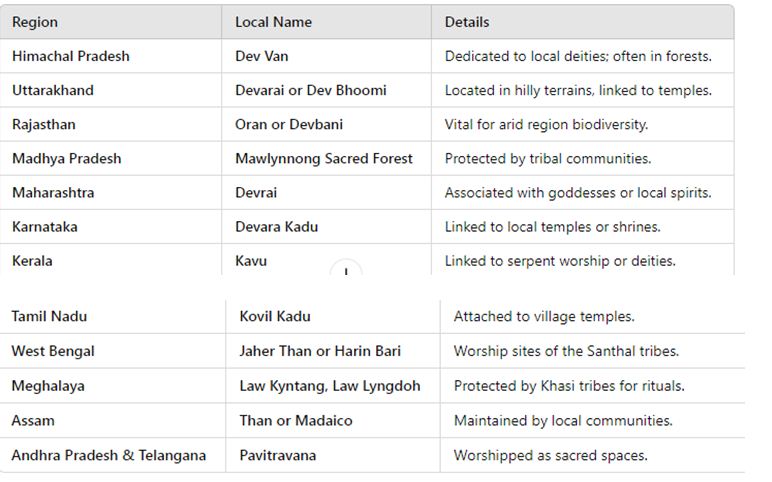December 19, 2024
What are Sacred groves?
Why in News? The Supreme Court of India has recently directed the Union government to make a comprehensive policy for managing sacred groves across the country.
About Sacred groves:
- They are small patches of forests or natural vegetation that are protected by local communities due to religious or cultural beliefs.
- These areas are considered sacred and often dedicated to local deities, spirits, or ancestral figures.
- They play a crucial role in conserving biodiversity, preserving traditional ecological knowledge, and maintaining cultural heritage.
Key Features of Sacred Groves:
Ecological Importance:
- Act as reservoirs of biodiversity, housing rare and endangered species of flora and fauna.
- Serve as carbon sinks, aiding in climate regulation.
- Protect soil and water resources.
Cultural and Religious Significance:
- Associated with local deities, spirits, or religious rituals.
- Often act as sites for community gatherings and festivals.
Traditional Conservation Practices:
- Protected through unwritten community rules or taboos.
- Activities like hunting, logging, or agriculture are prohibited or restricted.

पवित्र उपवन:
चर्चा में क्यों? भारत के सर्वोच्च न्यायालय ने हाल ही में केंद्र सरकार को देश भर में पवित्र उपवनों के प्रबंधन के लिए एक व्यापक नीति बनाने का निर्देश दिया है।
पवित्र उपवनों के बारे में:
- वे जंगलों या प्राकृतिक वनस्पतियों के छोटे-छोटे टुकड़े हैं जिन्हें स्थानीय समुदायों द्वारा धार्मिक या सांस्कृतिक मान्यताओं के कारण संरक्षित किया जाता है। इन क्षेत्रों को पवित्र माना जाता है और अक्सर स्थानीय देवताओं, आत्माओं या पूर्वजों को समर्पित किया जाता है। वे जैव विविधता के संरक्षण, पारंपरिक पारिस्थितिक ज्ञान को संरक्षित करने और सांस्कृतिक विरासत को बनाए रखने में महत्वपूर्ण भूमिका निभाते हैं।
पवित्र उपवनों की मुख्य विशेषताएँ
पारिस्थितिक महत्व:
- जैव विविधता के भंडार के रूप में कार्य करते हैं, वनस्पतियों और जीवों की दुर्लभ और लुप्तप्राय प्रजातियों का आवास हैं।
- कार्बन सिंक के रूप में कार्य करते हैं, जलवायु विनियमन में सहायता करते हैं।
- मिट्टी और जल संसाधनों की रक्षा करते हैं।
सांस्कृतिक और धार्मिक महत्व:
- स्थानीय देवताओं, आत्माओं या धार्मिक अनुष्ठानों से जुड़े हैं।
- अक्सर सामुदायिक समारोहों और त्योहारों के लिए स्थल के रूप में कार्य करते हैं।
पारंपरिक संरक्षण प्रथाएँ:
- अलिखित सामुदायिक नियमों या वर्जनाओं के माध्यम से संरक्षित।
- शिकार, लकड़ी काटना या कृषि जैसी गतिविधियाँ निषिद्ध या प्रतिबंधित हैं.
October 17, 2025
October 16, 2025
October 6, 2025
September 24, 2025
